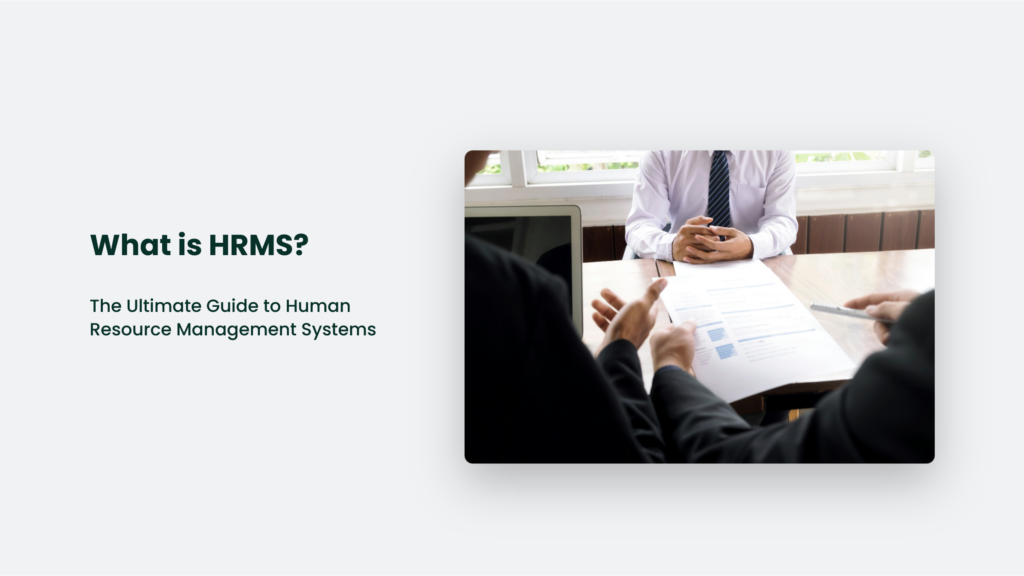Let’s face it: managing people is hard. It’s like herding cats, except the cats have employment contracts and performance reviews. Enter the HRMS – Human Resource Management System. It’s the Swiss Army knife of HR tools, designed to make your life easier and your employees’ lives… well, more efficiently managed. So, buckle up and learn what is HRMS?

The HRMS Lowdown: More Than Just a Fancy Spreadsheet
Remember the days when HR meant mountains of paperwork and filing cabinets that threatened to topple over and bury some poor, unsuspecting intern? Those days are (thankfully) behind us. An HRMS software suite handles all those pesky HR tasks that used to eat up your time faster than free doughnuts in the break room.
What is HRMS?
An HRMS is like that overachieving colleague who manages to do everything and still has time for a lunchtime yoga session. It typically covers:
Employee data management
- Payroll processing
- Time and attendance tracking
- Benefits administration
- Recruitment and onboarding
- Performance management
- Training and development
- Compliance management
The Evolution of HRMS: From Punch Cards to AI
Back then, HR was all about punch cards and paper trails. Then came the digital revolution, and suddenly, we had databases and spreadsheets. But the modern HRMS? It’s a whole different ballgame.
Today’s HRMS systems are cloud-based, mobile-friendly, and often come with a side of artificial intelligence. They’re not just about storing data anymore; they’re about providing insights, predicting trends, and even helping with strategic decision-making.
The HRMS Market: Big Business for Big (and Small) Business
If you think HRMS is just for the big players, think again. The global HRMS market was valued at $16.7 billion in 2022 and is expected to reach $33.5 billion by 2028. That’s a lot of zeros, folks. And it’s not just Fortune 500 companies getting in on the action.
The global human resource management market was valued at USD 23.6 billion in 2022. It is projected to grow at a Compound Annual Growth Rate (CAGR) of 13% from 2023 to 2032, reaching an estimated USD 34.7 billion by 2032.
Why You Need an HRMS (Even If You Think You Don’t)
But I’m a small business,” you might say. “I know all my employees by name. Why do I need fancy software?” Well, let me tell you a story. I once knew a startup founder who prided himself on his personal touch.
He knew everyone’s birthday, kids’ names, and pets’ favourite toys. But as the company grew, things started falling through the cracks. Payroll errors crept in, training records went missing, and compliance issues didn’t even get me started.
An HRMS isn’t about replacing the human touch; it’s about freeing up your time so you can focus on the stuff that really matters—like remembering to buy treats for Fluffy, the office cat.
The Benefits of HRMS: More Than Just Fewer Paper Cuts
- Improved Efficiency: Automate routine tasks and say goodbye to manual data entry errors. Studies show that companies using HRMS can reduce HR administrative work by up to 40%.
- Better Decision Making: With all your HR data in one place, you can spot trends and make informed decisions. It’s like having a crystal ball but with more graphs and fewer mystical smoke effects.
- Enhanced Employee Experience: Self-service portals mean employees can update their own information, check their benefits, and request time off without playing phone tag with HR.
- Compliance Made Easy: Keep up with changing regulations without breaking a sweat. According to a 2023 survey by Thomson Reuters, 80% of corporate risk and compliance professionals agreed that their organization views risk and compliance as valuable business advisory functions.
- Cost Savings: While there’s an upfront investment, an HRMS can lead to significant long-term savings. Companies report an average of 22% reduction in HR costs after implementation.
Choosing the Right HRMS: It’s Not One-Size-Fits-All
Picking an HRMS is like choosing a life partner. Okay, maybe not that serious, but it’s a big decision. Here’s what to consider:
- Your Company Size and Growth Plans: Are you a startup looking to scale or an established company with complex needs?
- Features You Need: Do you just need basic payroll, or are you looking for advanced analytics and AI-driven insights?
- Integration Capabilities: Can it play nicely with your existing systems?
- User-Friendliness: If it’s harder to use than assembling IKEA furniture, your employees won’t embrace it.
- Mobile Accessibility: In today’s world, if it’s not mobile-friendly, it might as well be written in hieroglyphics.
- Cost: Remember, the cheapest option isn’t always the best. Consider the long-term ROI.
Implementing Your HRMS: Less Pain, More Gain
So you’ve chosen your HRMS. Now comes the fun part – implementation. Here’s a tip: treat it like a marathon, not a sprint. Rush it, and you’ll end up with a system that’s about as useful as a chocolate teapot.
- Plan Thoroughly: Map out your processes and decide what data you need to migrate.
- Train Your Team: Even the best system is useless if no one can use it.
- Communicate Clearly: Let everyone know what’s changing and why it’s awesome.
- Test, Test, Test: Iron out the kinks before you go live.
- Gather Feedback: Listen to your users and be ready to make adjustments.
The Future of HRMS: Crystal Ball Not Included
What does the future hold for HRMS? If I knew that for certain, I’d be writing this from my private island. But based on current trends, we can expect:
- More AI and Machine Learning: Imagine an HRMS that can predict which employees are likely to leave and suggest retention strategies.
- Enhanced analytics: Predictive analytics can help with everything from workforce planning to identifying future leaders.
- Greater Focus on Employee Experience: HRMS will likely become more employee-centric, with features designed to boost engagement and well-being.
- Increased Integration: Expect HRMS to interact even more nicely with other business systems, creating a seamless flow of data across the organization.
Wrapping It Up: The HRMS Bottom Line
An HRMS isn’t just a fancy tool to impress your tech-savvy friends at dinner parties (although it can do that, too). It’s a powerful ally in the quest to manage your human resources effectively and efficiently. Remember, at the end of the day, an HRMS is about people. It’s about freeing time to focus on what matters – building a great workplace where people can thrive. And does it help you avoid drowning in paperwork and compliance headaches? Well, that’s just the cherry on top.
Frequently Asked Questions:
How long does it take to implement an HRMS?
Implementation time can range from a few weeks for small, cloud-based systems to several months for large, complex implementations.
Can an HRMS really improve employee engagement?
Yes! An HRMS can significantly boost employee satisfaction and engagement by providing self-service options, streamlining processes, and enabling better communication.
Can an HRMS really improve employee engagement?
Yes! An HRMS can significantly boost employee satisfaction and engagement by providing self-service options, streamlining processes, and enabling better communication.




